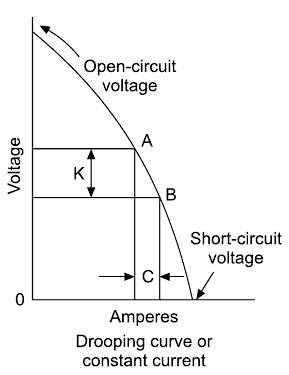V-I Characteristics of an ARC Welding
Volt-ampere or V.I. characteristics of a welding plant have great effect on the process of welding as different welding processes use welding plants with different V.I. characteristics. The V.I. characteristics indicate the relationship of the arc voltage and the arc current. During welding, the arc length between the electrode tip and the workplace determines the arc resistance and consequently the potential drop across the arc. In other words, the arc length determines the arc voltage. Longer the arc, higher the arc voltage. And it is this voltage which permits a certain flow of current according to the characteristics of the welding plant.
The three main types of welding plant characteristics are:
Drooping (or Constant current) type
Flat (or Constant voltage) type
Rising voltage type.
Constant current (drooping voltage) output is preferred for manual arc welding because small variations in voltage caused by variations in arc length, do not significantly affect the current output and deposition rate. A DC generator is driven by a prime mover (electric motor or diesel engine) which produces DC current in either or reversed polarity. The current supplied by DC generator is alternating that can be converted to direct quantity by the use of a commutator.
The differential compound DC generator is used as a welding generator since it has drooping volt-amp characteristics. As the load current increases, the net flux due to the series and the shunt fields in opposition decrease and hence the generated EMF.
